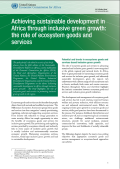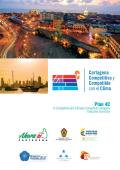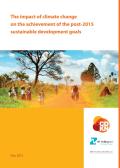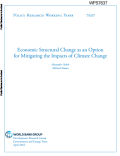
This policy brief is the third in a series of six briefs drawn from the fifth edition of the Sustainable Development Report on Africa.
It is a joint publication of the Economic Commission for Africa (ECA), the Food and Agriculture Organization of the United Nations, the United Nations Environment Programme, the United Nations Industrial Development Organization and the United Nations Development Programme on the theme “achieving sustainable development in Africa through inclusive green growth”. The brief highlights the role of ecosystem goods and services in promoting inclusive green growth in the region.

This report outlines the strategies in place for the World Heritage City of Cartagena, Colombia to become an icon of climate compatible development, where the risk of climate change is converted into an opportunity for development.
The future of Cartagena is uncertain and vulnerable to climate change. Even a 2C increase in temperatures will likely raise sea levels in the area by 60cm by 2040. Further risks of drought, and increased rainfall have motivated action to prevent such events unfolding and hampering the future of its citizens.
The vision of Plan 4C is that by 2040, Cartagena de Indias will be recognised as a city that is a model of urban and coastal planning based on climate compatible development: where adaptation and mitigation measures will reduce indices of vulnerability to climate change, improve efficiency of public investment, the quality of life of its inhabitants and the competitiveness of its sectors.

A high-ambition agreement that provides a clear policy framework for action on climate change, incentivises international cooperation, and mobilises additional resources for mitigation and adaptation activities is essential to give us the best chance of achieving the SDGs by 2030. Likewise, strong SDGs will help to lay the policy groundwork for achieving and implementing a more ambitious climate agreement.
This report, The impact of climate change on the achievement of the post-2015 sustainable development goals, considers impacts on development over the next 15 years, under two scenarios for the 2015 climate change agreement: a high-ambition agreement and a low-ambition agreement. It looks at associated policies and levels of investment in mitigation and adaptation. The high-ambition scenario used is based on the UNFCCC aim to limit global warming to a 2°C increase on pre-industrial temperatures.

Improving the resilience of the economy in the face of uncertain climate change damages involves irreversible investments to scale up new technologies that are less vulnerable to the effects of climate change. The benefit of having such options includes the avoided welfare cost of diverting consumption to scaling up the new technology after production possibilities have been diminished by climate change impacts. This needs to be balanced against the upfront cost of scaling up a technology that is potentially less productive than incumbent technologies. The paper uses a real options approach to investigate this trade-off, based on numerical simulation of a multi-period model of economic growth and climate change impacts that includes a one-time cost associated with scaling up the alternative technology. The value of the option provided by investment in the more resilient technology depends on the ex-ante volatility of climate change damages, as well as how rapidly climate change degrades the productivity of the economy's established technology.

The UNDP-UNEP Poverty Environment Initiative (PEI) offers a unique way of tackling these issues together by offering policy options to governments on how sustainable use of natural resources can help reduce poverty and maintain economic growth. With strong support from six donors globally, PEI in Asia Pacific is working with nine countries to mainstream pro-poor natural resource management into economic policies and decision making to achieve more inclusive green economies.
